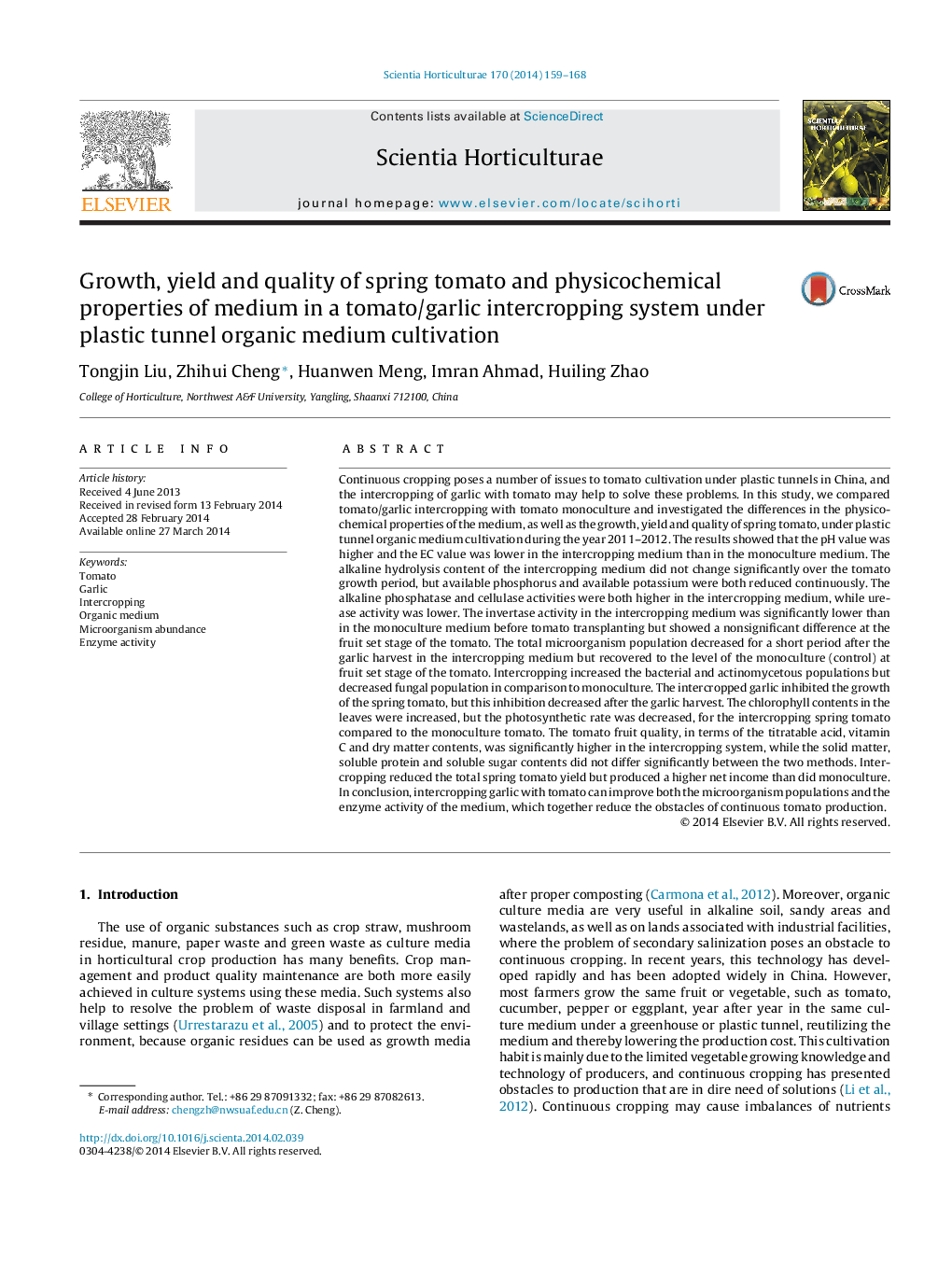| کد مقاله | کد نشریه | سال انتشار | مقاله انگلیسی | نسخه تمام متن |
|---|---|---|---|---|
| 6407197 | 1628828 | 2014 | 10 صفحه PDF | دانلود رایگان |
عنوان انگلیسی مقاله ISI
Growth, yield and quality of spring tomato and physicochemical properties of medium in a tomato/garlic intercropping system under plastic tunnel organic medium cultivation
ترجمه فارسی عنوان
رشد، عملکرد و کیفیت گوجه فرنگی بهاره و ویژگی های فیزیکوشیمیایی در محیط کشت گوجهفرنگی / سیر مخلوط
دانلود مقاله + سفارش ترجمه
دانلود مقاله ISI انگلیسی
رایگان برای ایرانیان
کلمات کلیدی
گوجه فرنگی، سیر، کشت مخلوط، محیط زیست آلی، فراوانی میکروارگانیسم، فعالیت آنزیم،
موضوعات مرتبط
علوم زیستی و بیوفناوری
علوم کشاورزی و بیولوژیک
دانش باغداری
چکیده انگلیسی
Continuous cropping poses a number of issues to tomato cultivation under plastic tunnels in China, and the intercropping of garlic with tomato may help to solve these problems. In this study, we compared tomato/garlic intercropping with tomato monoculture and investigated the differences in the physicochemical properties of the medium, as well as the growth, yield and quality of spring tomato, under plastic tunnel organic medium cultivation during the year 2011-2012. The results showed that the pH value was higher and the EC value was lower in the intercropping medium than in the monoculture medium. The alkaline hydrolysis content of the intercropping medium did not change significantly over the tomato growth period, but available phosphorus and available potassium were both reduced continuously. The alkaline phosphatase and cellulase activities were both higher in the intercropping medium, while urease activity was lower. The invertase activity in the intercropping medium was significantly lower than in the monoculture medium before tomato transplanting but showed a nonsignificant difference at the fruit set stage of the tomato. The total microorganism population decreased for a short period after the garlic harvest in the intercropping medium but recovered to the level of the monoculture (control) at fruit set stage of the tomato. Intercropping increased the bacterial and actinomycetous populations but decreased fungal population in comparison to monoculture. The intercropped garlic inhibited the growth of the spring tomato, but this inhibition decreased after the garlic harvest. The chlorophyll contents in the leaves were increased, but the photosynthetic rate was decreased, for the intercropping spring tomato compared to the monoculture tomato. The tomato fruit quality, in terms of the titratable acid, vitamin C and dry matter contents, was significantly higher in the intercropping system, while the solid matter, soluble protein and soluble sugar contents did not differ significantly between the two methods. Intercropping reduced the total spring tomato yield but produced a higher net income than did monoculture. In conclusion, intercropping garlic with tomato can improve both the microorganism populations and the enzyme activity of the medium, which together reduce the obstacles of continuous tomato production.
ناشر
Database: Elsevier - ScienceDirect (ساینس دایرکت)
Journal: Scientia Horticulturae - Volume 170, 7 May 2014, Pages 159-168
Journal: Scientia Horticulturae - Volume 170, 7 May 2014, Pages 159-168
نویسندگان
Tongjin Liu, Zhihui Cheng, Huanwen Meng, Imran Ahmad, Huiling Zhao,
